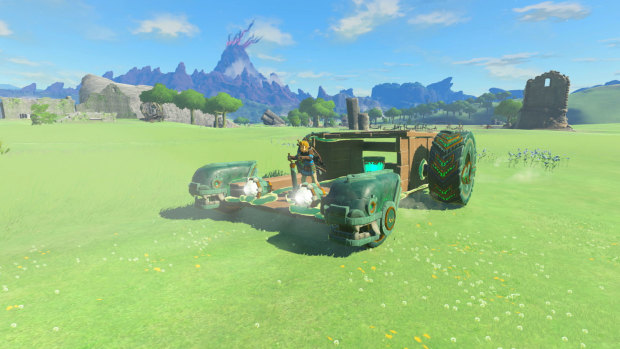
Link’s powers in Tears of the Kingdom
- Recall: rewind time but only for a single object. If a rock falls from the sky, stand on top and reverse it. Or, if an enemy rolls an explosive barrel at you, just rewind it back up the hill.
- Ultrahand: move any item telekinetically, and stick it to others. Useful for turning a tree into a bridge, but also for constructing incredibly elaborate structures, and even vehicles.
- Fuse: make any object a functional part of your weapon, shield or arrows. A hive on a boomerang to emit bees, a monster eye on an arrow to heat-seek, a mushroom on a shield to puff out spores.
- Ascend: shoot directly upwards anywhere there’s a roof or structure above, and swim intangibly to the surface. It’s an easy escape from caves, and a quick way to zoom up to the top of mountains.
It’s clear the designers were paying close attention to how many Breath of the Wild players used the tools at their disposal to push the limits of what they could build and create, and so leant hard on tools for creativity in the sequel. There’s a Minecraft vibe to spending hours crafting boats, cars, planes or structures from the resources you’ve found, yet at the same time there are many opportunities to solve problems or achieve goals (either dictated by the game or made up by the player) using the powers.
And there’s an innate joy in watching your crappily hacked-together designs barely managing to serve their purpose, battling against the indifferent physics system to stay on a rickety rail or keep from sinking just long enough. With few exceptions, the answer to “I wonder if I can do this?” is yes, and the game usually rewards you for it.

Using found materials, and the mysterious “Zonai devices” that have fallen from the sky, Link can build all sorts of structures, vehicles and machines.
At the same time, Tears of the Kingdom has a level of accessibility that is lacking in many open systems-based games. Beyond the opening area, there are no strict requirements for where you should go or what you should do, meaning you can progress at your own pace or focus on the parts of the adventure you like, and still have many hours of fun.
And if you happen to go on Twitter and see some dedicated and intelligent gamer pulling off something incredible — for example, shooting a bundle of wood to a sky island on an arrow, waiting for it to fall, sticking a platform on top and then reversing time for the wood so it sends her to the sky island like a flying elevator — odds are you can replicate it. It’s coming up with imaginative and inventive ideas that help you do big things in this game, rather than having supernatural thumb-moving abilities.
The genius here is that, aside from expanding his hearts (the number of hits you can take), stamina (how far you can run, climb and float) and batteries (how long your creations can keep going), Link doesn’t really grow over the course of this adventure — you do. Even, or especially, when you fail. For example, your catastrophic attempt to put a spinning flamethrower on a horse-drawn carriage may teach you that it’s very easy to propagate fire in tall grass, and that the resulting updraft can lift you quite high if you escape on the paraglider. Or you might just learn that a horse will not stay put with such a contraption attached.
Loading
Your ability to survive tough fights and solve complex situations relies primarily on your understanding of the world, which is especially true in this game compared to its predecessor, because you’ll be making your most powerful weapons and items rather than finding them.
It’s too early to tell whether Tears of the Kingdom will supplant Breath of the Wild as the most popular Zelda. On the one hand, it is a direct sequel, which could limit its appeal to those who played the original. But on the other, the time-travelling narrative doesn’t require much pre-existing knowledge, and it’s likely the ongoing conversation about everything you can do and see in this game will be much broader than before, and continue for a very long time.
Get news and reviews on technology, gadgets and gaming in our Technology newsletter every Friday. Sign up here.



























